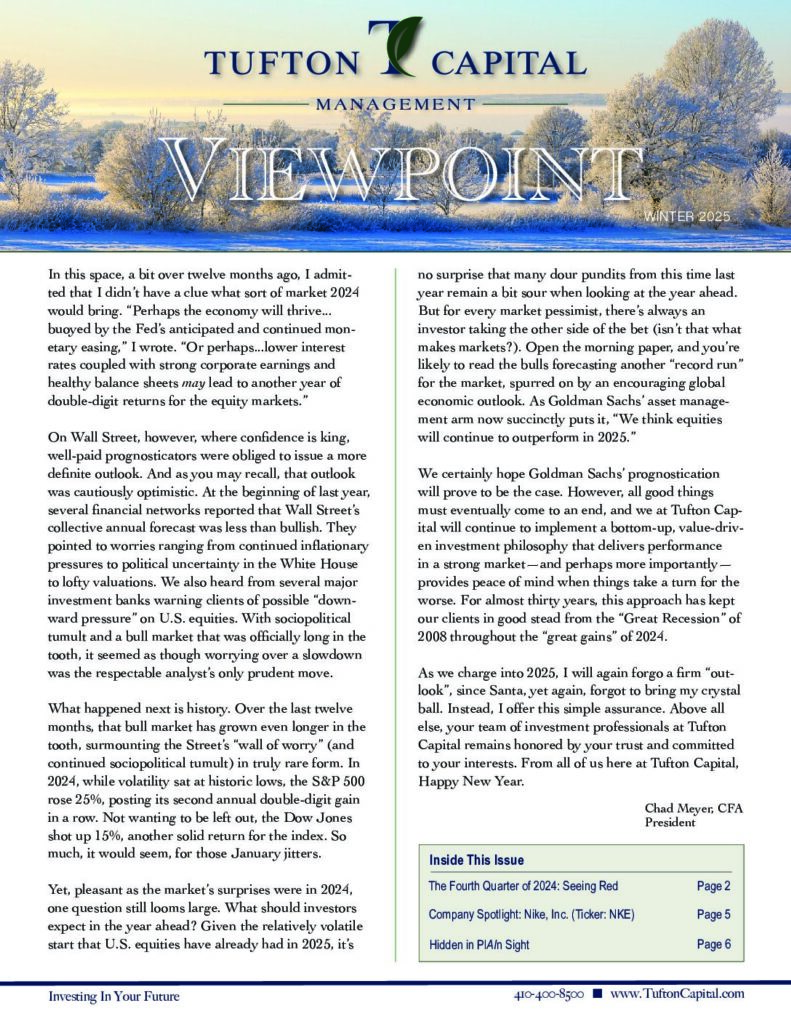 The volatility that we’ve experienced in the global markets in recent months serves as a great reminder: although markets generally “climb a wall of worry” over the long run, they don’t do so in a straight line. While the first half of 2015 resulted in a flat S&P 500, this year’s third quarter brought the much-anticipated correction that we (and much of Wall Street) had been patiently awaiting.
The volatility that we’ve experienced in the global markets in recent months serves as a great reminder: although markets generally “climb a wall of worry” over the long run, they don’t do so in a straight line. While the first half of 2015 resulted in a flat S&P 500, this year’s third quarter brought the much-anticipated correction that we (and much of Wall Street) had been patiently awaiting.
But while corrections are no fun for investors, they are a normal and necessary component of the long-term market cycle. Moreover, market pullbacks give value investors like us opportunities to put our expertise to work. Our firm has been finding value in stocks such as Emerson Electric (EMR), which now trades at 12 times next year’s earnings while offering a 4.4% yield (please see our EMR analysis on Page 7). And with companies such as Procter & Gamble (PG) and Chevron (CVX) yielding 3.7% and 5.5%, respectively, good investments become even better ones in down markets. So while corrections (more…)
 The month of August showed the return of volatility in the financial markets. The S&P 500 dropped 11% in the span of seven days and the VIX, widely known as “the Fear Index,” hit an intraday high of 53 – a level not seen since the financial crisis. In one day of trading, the Dow Jones Industrial Average opened down more than 1,000 points within the first hour, causing a “Flash Crash” as many ETF investors attempted to run for the exits. All of this chaos resulted in the >10% correction we had been long awaiting.
The month of August showed the return of volatility in the financial markets. The S&P 500 dropped 11% in the span of seven days and the VIX, widely known as “the Fear Index,” hit an intraday high of 53 – a level not seen since the financial crisis. In one day of trading, the Dow Jones Industrial Average opened down more than 1,000 points within the first hour, causing a “Flash Crash” as many ETF investors attempted to run for the exits. All of this chaos resulted in the >10% correction we had been long awaiting.
Throughout this volatile time, I received texts and calls from relatives asking if they should sell or trim their portfolios. My response often was “What? Why would you? I’m buying!” As we have mentioned in previous articles, >10% corrections are common and have occurred about every two years since 1957. Selling or trimming your portfolio during these corrections is one of the (more…)
 Hardesty Capital Management spends a considerable amount of time searching the universe of publicly traded companies for undervalued stocks to purchase in our clients’ accounts. Aside from research roles, our portfolio managers are responsible for all aspects of portfolio construction and supervision, which includes the management of gains and losses that are realized in our clients’ taxable accounts. Of course, tax implications are not the paramount concern in the management of a portfolio, but trading responsibly with this in mind can make a big difference for investors come tax day in April.
Hardesty Capital Management spends a considerable amount of time searching the universe of publicly traded companies for undervalued stocks to purchase in our clients’ accounts. Aside from research roles, our portfolio managers are responsible for all aspects of portfolio construction and supervision, which includes the management of gains and losses that are realized in our clients’ taxable accounts. Of course, tax implications are not the paramount concern in the management of a portfolio, but trading responsibly with this in mind can make a big difference for investors come tax day in April.
Selling at a loss may seem to run counter to your investment goals, but because the IRS allows for investment losses to be used to offset capital gains, investors should look to make the best of an otherwise unprofitable investment. With that in mind, and with the end of the year quickly approaching, investors should consider selling poor performers in their taxable accounts by conducting tax loss sales. This strategy is especially good for investors in the 25-35% Federal tax brackets who must (more…)
 Many financial advisors build a book of business using mutual funds for their affluent clients. Is it because funds have favorable characteristics and offer stronger investment returns? Absolutely not – mutual funds have many drawbacks!! First, they limit an advisor’s ability to customize a portfolio and manage risk effectively. Second, they add an additional layer of fees, which reduces an investor’s returns. Third, they are inefficient for investors who want to manage their tax bills. (Please see our Tax Loss Harvesting article on page 5.) Small retail investors have few options and mutual funds may make sense for them. Fortunately, our clients enjoy a customized approach to managing their money. We invest in a diversified portfolio of individual stocks and bonds to meet your goals. Please read on and you will understand why we favor our approach.
Many financial advisors build a book of business using mutual funds for their affluent clients. Is it because funds have favorable characteristics and offer stronger investment returns? Absolutely not – mutual funds have many drawbacks!! First, they limit an advisor’s ability to customize a portfolio and manage risk effectively. Second, they add an additional layer of fees, which reduces an investor’s returns. Third, they are inefficient for investors who want to manage their tax bills. (Please see our Tax Loss Harvesting article on page 5.) Small retail investors have few options and mutual funds may make sense for them. Fortunately, our clients enjoy a customized approach to managing their money. We invest in a diversified portfolio of individual stocks and bonds to meet your goals. Please read on and you will understand why we favor our approach.
Often, advisors put clients into mutual funds because they lack robust in-house research, or it simply frees up the advisors’ time to go find new business. While funds offer investors instant diversification, it’s a one-size-fits-all approach. A fund manager’s objective may be quite different from that of the investor. For example, a manager’s compensation may be linked to outperforming a benchmark with no consideration for the level of risk taken, the amount of taxes passed on (more…)
 As the third quarter wound to a close, we learned from the Bureau of Economic Analysis that gross domestic product for the second quarter was revised to 3.9% year-over-year growth from a previous estimate of 3.7%. Despite the strong economic data, the stock market posted dismal performance, with the broad Standard & Poor’s 500 index down 6.9% for the quarter. Volatility has reemerged as investors face an uncertain landscape. Although we often analyze economic data to provide insight into future stock market returns, more often is the case that the stock market provides a glimpse into the future of the economy.
As the third quarter wound to a close, we learned from the Bureau of Economic Analysis that gross domestic product for the second quarter was revised to 3.9% year-over-year growth from a previous estimate of 3.7%. Despite the strong economic data, the stock market posted dismal performance, with the broad Standard & Poor’s 500 index down 6.9% for the quarter. Volatility has reemerged as investors face an uncertain landscape. Although we often analyze economic data to provide insight into future stock market returns, more often is the case that the stock market provides a glimpse into the future of the economy.
The global economy is as weak as it has been since the Great Recession. A slowing of the Chinese economy is the latest cause of indigestion. It is difficult to overemphasize the importance of the second largest economy in the world. With reported annual average GDP expansion rates in excess of 7% for many years, the Chinese economy has been the global growth driver. As Chinese production has slowed, the prices of raw materials for that (more…)
 Our outlook for 2015, presented in our January issue, was titled “Don’t Fight the Fed.” Low interest rates have made bonds an unattractive investment option during a period when common stocks continue to plow higher. However, with the Federal Reserve now poised to begin raising interest rates, the uncertainty regarding the timing and magnitude of rate increases has left the equity and fixed income markets skittish. The market, in anticipation of Fed action, sent stocks lower during the second quarter. By the first week of June, nearly all stock market gains for the year had been erased. The Fed’s statement following its mid-June meeting led to a market rally as commentary was more dovish than anticipated. The bond market has also moved in anticipation of higher rates. The yield on the 10-year U.S. Treasury followed suit, climbing from a low of 1.86% to as high as 2.48% during the quarter.
Our outlook for 2015, presented in our January issue, was titled “Don’t Fight the Fed.” Low interest rates have made bonds an unattractive investment option during a period when common stocks continue to plow higher. However, with the Federal Reserve now poised to begin raising interest rates, the uncertainty regarding the timing and magnitude of rate increases has left the equity and fixed income markets skittish. The market, in anticipation of Fed action, sent stocks lower during the second quarter. By the first week of June, nearly all stock market gains for the year had been erased. The Fed’s statement following its mid-June meeting led to a market rally as commentary was more dovish than anticipated. The bond market has also moved in anticipation of higher rates. The yield on the 10-year U.S. Treasury followed suit, climbing from a low of 1.86% to as high as 2.48% during the quarter.
Although the Fed is nearing an inflection point, we do not see near-term rate actions negatively impacting the economy. In the Fed we trust: we believe any rate increases will be slow and measured. (more…)
 Many investors are riding high and feeling great as we continue to see gains in one of the longest bull markets since the 1940s.
Many investors are riding high and feeling great as we continue to see gains in one of the longest bull markets since the 1940s.
As we know, the bull market will only last so long: sooner or later, we are going to see a correction. We are monitoring the market’s higher valuation very closely. No one knows when it will come or how large the dip will be, but we do know it is coming. What’s important is staying strong in your investment strategy and fighting the urge to sell.
Retail investors (those who trade their portfolios non-professionally) have performance that significantly lags the market overall. This dynamic occurs because they tend to act on emotion, selling at the bottom and missing the large early gains of a recovery. (more…)
 The U.S. Shale Revolution has proved to be nothing short of remarkable. Through the use of horizontal drilling and hydraulic fracturing, also known as “fracking,” the U.S. has become one of the world’s largest oil producers with production of 9.7 million barrels per day, representing approximately 10% of global production. However, many investors believe that the recent decline in oil prices to $60 per barrel has posed a threat to many U.S. shale producers.
The U.S. Shale Revolution has proved to be nothing short of remarkable. Through the use of horizontal drilling and hydraulic fracturing, also known as “fracking,” the U.S. has become one of the world’s largest oil producers with production of 9.7 million barrels per day, representing approximately 10% of global production. However, many investors believe that the recent decline in oil prices to $60 per barrel has posed a threat to many U.S. shale producers.
Although prior oil crashes have imposed drastic effects on oil producers, the dynamics of shale drilling offer a different production scenario. While production from a conventional well can produce a steady volume for several decades, production from the average shale well typically declines an estimated 60% to 70% after the first year. This drop forces companies to have more flexibility in well development in addition to well production. (more…)
A succession plan for your business is one of the most important safeguards you can use to ensure the company’s future success. Approximately one third of family businesses that transfer to the next generation are successful, and only 15 percent make it to the third generation. Choosing tomorrow’s leaders and formulating a plan for your retirement, death, divorce or disability are tasks that should be done early and tweaked often. The transfer of power and wealth can provide a smooth transition or can be the demise of a company, depending on how future leaders are chosen and groomed, and how tax and estate planning implications are handled.
There are various business succession options available to the owners of privately held businesses. These include:
- Transfer of ownership to the next generation
- Employee stock ownership plan (ESOP)
- Public offering
- Recapitalization of the business
- Sale of the business to a third party
- Liquidation of the business
Transfer Ownership to Next Generation
When choosing and grooming successors for your business, you must consider their business strength and savvy, and the psychological and emotional impacts of any decision on employees and family members. (more…)
 Mr. Rubin joins Hardesty Capital as Vice President, Senior Portfolio Manager, and member of the Investment Committee. His role is to manage existing high net worth client portfolios while also increasing Hardesty Capital’s client base. Mr. Rubin also uses his experience as Co-Head of Equity Research at Mercantile Trust (now PNC) to actively manage the investment research process with the Investment Committee.
Mr. Rubin joins Hardesty Capital as Vice President, Senior Portfolio Manager, and member of the Investment Committee. His role is to manage existing high net worth client portfolios while also increasing Hardesty Capital’s client base. Mr. Rubin also uses his experience as Co-Head of Equity Research at Mercantile Trust (now PNC) to actively manage the investment research process with the Investment Committee.
He has worked in many leadership roles throughout his 22 years in the investment management industry. Most recently, he was Senior Investment Advisor at PNC Wealth Management, where he spent twelve years working with high net worth clients. He also served as Senior Equity Research Analyst, where he was responsible for research coverage and securities recommendations to portfolio managers. Prior to that, he spent five years at Legg Mason Wood Walker (now Stifel Nicolaus) as an Equity Research Analyst.
Mr. Rubin successfully completed the Chartered Financial Analyst program in 2000. He received his Certified Public Accountant (CPA) certificate in 1994 and his Masters of Business Administration (MBA) from Loyola University Maryland in 1998. Mr. Rubin is a member of the Baltimore CFA Society and the CFA Institute.
 Mr. Peck joins Hardesty Capital as Marketing Associate and is responsible for identifying prospects as well as other marketing efforts. Prior to joining Hardesty Capital, Mr. Peck was a Client Service Associate at Morgan Stanley Wealth Management. He graduated from Denison University in 2014 and served as an intern for Hardesty Capital during the summer of 2013.
Mr. Peck joins Hardesty Capital as Marketing Associate and is responsible for identifying prospects as well as other marketing efforts. Prior to joining Hardesty Capital, Mr. Peck was a Client Service Associate at Morgan Stanley Wealth Management. He graduated from Denison University in 2014 and served as an intern for Hardesty Capital during the summer of 2013.
We are excited for Rick and Neill to join the team at Hardesty Capital. We have so much opportunity and will continue our growth strategy with the addition of new staff while maintaining our integrity as a value-oriented investment firm.
Dear Clients and Friends,
It is with great sadness that we announce the passing of our firm’s co-founder, James D. Hardesty. Jim died peacefully on May 12th after complications from an ongoing, long-term illness.
Jim was a brilliant, thoughtful man. He was truly an intellectual and known for his photographic memory. Jim’s ability to recall names and dates with precision made him a renowned storyteller. Also renowned, as he would admit, was the long-windedness of those stories.
Over the course of his life, Jim became successful because he lived his passion. Rather than playing golf or tennis, he chose to fill his time reading, thinking, and analyzing balance sheets. A protégé of Benjamin Graham, Jim always tried to instill his love of the brilliant simplicity of value investing by giving all new hires a copy of Graham’s 1949 book The Intelligent Investor.
Jim had recently retired from Hardesty Capital, the firm he co-founded in 1995. His vision and skill blossomed into a firm that is now at all-time highs in every conceivable measure. He leaves a remarkable legacy.
Please keep Jim’s wife Lindsay and daughter Ellen in your prayers.
Sincerely,
The Hardesty Capital Family
Hunt Valley, MD – Hardesty Capital Management announced the retirement of company cofounder James D. Hardesty, CFA, effective April 15, 2015. Hardesty’s decision to retire will end an extraordinary 45-year career in the investment management industry.
Mr. Hardesty served as Chairman of the Board, Market Strategist and Chief Economist. He cofounded Hardesty Capital in 1995 with V. Randolph McMenamin, CFA, Managing Director and Vice President of Hardesty Capital Management. After retiring, Mr. Hardesty now serves as Chairman Emeritus of Hardesty Capital, and he continues to serve in a consulting role mentoring young staff members.
Mr. Hardesty held numerous leadership positions in the industry prior to Hardesty Capital, including Chief Investment Officer and Executive Vice President at Mercantile Safe Deposit and Trust Company. Under his leadership at Hardesty Capital, assets under management have grown to just under one billion dollars.
In addition to his business activities, Jim sits on a number of industry and non-profit boards. He currently serves as Vice Chairman of the Board for the Harford Mutual Insurance Company. Previously, he was Trustee of LINC (Learning Independence Through Computers) as well as the Board of Family & Children’s Services of (more…)
 In today’s highly regulated world of retirement planning for your business and your employees, owners offering 401(k) plans have the increasing responsibility of serving as a fiduciary to the plan. Not meeting your fiduciary duties as a plan sponsor is a violation of new ERISA regulations and leaves you vulnerable to potential litigation if the plan underperforms.
In today’s highly regulated world of retirement planning for your business and your employees, owners offering 401(k) plans have the increasing responsibility of serving as a fiduciary to the plan. Not meeting your fiduciary duties as a plan sponsor is a violation of new ERISA regulations and leaves you vulnerable to potential litigation if the plan underperforms.
As the owner of a business with a 401(k) plan, you and your board have a legal obligation, or a fiduciary duty, to act in the best interest of your employees. Many unsuspecting owners, or plan sponsors, hire outside advisors to oversee their plans who are not considered fiduciaries. By hiring non-fiduciaries as advisors (such as investment brokers or insurance agents), your legal responsibilities may not be upheld. Since these salespeople may put their companies’ (and their own) interests first, your fiduciary duty to your employees could be compromised. While these non-fiduciaries may have a “suitability standard” to provide you with reasonable financial products, these offerings are often likely to benefit the brokers more than your employees. (more…)
The true sources of excess returns
 The decision of how to allocate your money between asset classes (bonds, stocks, international, etc.) is important, we know. But just how important is it? There are many sources that say “over 90%” of your return comes from asset allocation. This oft-quoted statistic comes from a misinterpreted financial study from 1986 (“Determinants of Portfolio Performance,” by Gary P. Brinson, Randolph Hood, and Gilbert L. Beebower, published in the Financial Analysts Journal). What the study said was that asset allocation explained 93.6% of the variation in a portfolio’s quarterly returns. What does “that“ mean?
The decision of how to allocate your money between asset classes (bonds, stocks, international, etc.) is important, we know. But just how important is it? There are many sources that say “over 90%” of your return comes from asset allocation. This oft-quoted statistic comes from a misinterpreted financial study from 1986 (“Determinants of Portfolio Performance,” by Gary P. Brinson, Randolph Hood, and Gilbert L. Beebower, published in the Financial Analysts Journal). What the study said was that asset allocation explained 93.6% of the variation in a portfolio’s quarterly returns. What does “that“ mean?
In fact, even that statistic has been hotly debated and interpreted in many ways. For clarity on this issue, we look to the ever-academic CFA institute, which tells us that, as a rule, “about three-quarters of a typical fund’s variation in time-series returns comes from general market movement, with the remaining portion split roughly evenly between the specific asset allocation and active management.” (Here, “fund” is referring to balanced mutual funds and pension plans.) (more…)
 The US economy continued to strengthen in the fourth quarter of 2014. Further momentum in the domestic automobile sector, particularly from truck sales, resulted in annualized vehicle sales of 17 million, very close to the all-time highs of 2005. Gross Domestic Product advanced 5.0% in the third quarter, the strongest performance since the recession of 2009. Consumer Confidence reached 92.6, up from 77.5 a year ago, a very sharp confirmation that the economy is on an upward track. Other economic indicators, including inventory levels, operating ratios, and vendor performance all confirm that the recovery is strengthening.
The US economy continued to strengthen in the fourth quarter of 2014. Further momentum in the domestic automobile sector, particularly from truck sales, resulted in annualized vehicle sales of 17 million, very close to the all-time highs of 2005. Gross Domestic Product advanced 5.0% in the third quarter, the strongest performance since the recession of 2009. Consumer Confidence reached 92.6, up from 77.5 a year ago, a very sharp confirmation that the economy is on an upward track. Other economic indicators, including inventory levels, operating ratios, and vendor performance all confirm that the recovery is strengthening.
As positive as the news is on the domestic economy, the rest of the world has experienced a sudden, and in some cases, sharp contraction. European economies have retreated, particularly in Italy, Greece, and France. European central bankers have responded by dropping interest rates, which are now lower than those in the United States, signaling weakness and significant deflationary trends. In some of these southern European economies, unemployment rates for those under 25 now exceed 20%. (more…)



